Palm Springs, CA, Nov 2018
Monterey, CA Dec 2018
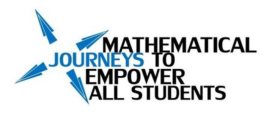

I have summarized each session with some simple (•) bulleted notes, red underline to encapsulate my big take-aways, and occasionally a brief italicized commentary. (Due to many duties at the conference this year, my session attendance was limited, thus why I am combining the two conference recaps here. )
Understanding the Resistant Teacher: Mike Flynn (Mount Holyoke), Coaching Pre-Conference Keynote (South)
- The Big Take-Away = Resistance is a Matter of Perspective
- Mike showed us this impactful video mash-up in which the Karate Kid is made to seem like the bully in the famous movie. In other words, leaders may see resistant teachers as the villains, but those same resistant teachers may see the change agents as the villains.

- He then shared a story of how he and a colleague spoke to his state government against some of the misguided changes the legislators were planning. In this situation, he was definitely a resistant educator who saw his public challenge to the new initiatives as the moral good. The video clip along with Mike’s story made it clear that writing off all resistant teachers as sticks in the mud, prevents us from understanding, and thus overcoming, the source of the resistance.
- Another powerful visual that Mike presented was the analogy of the Rider, the Elephant and the Path from the book, The Switch: How to Change Things When Change is Hard. In essence, the Rider is the rational part of our brain, and the Elephant is the emotional part, and the Path is the environment in which both are functioning. The Elephant wins out over the Rider in any conflict so leading change requires addressing all three: Directing the Rider, Motivating the Elephant and Shaping the Path.
- The 5 Why’s. This third major point of Mike’s talk appeared to resonate the most with the audience. It is a process by which a team identifies a problem, then asks 5 Why’s. Each successive why is in response to the previous answer, much like a logical syllogism: Why did A happen? Because of B. Why did B happen? Because of C… This process continues for 5 questions, eventually getting to the root cause of the problem. Then the members are assigned corrected actions to each of the answers/problems identified, so the issue does not happen again. This process is documented in more detail at the following blog on workplace culture.
Mike’s talk reminded me how important it is to include all teachers, including the reluctant ones, in the change process. Which means creating a culture of collaboration (Shaping the Path) is critical.
I Think…Doesn’t Belong, Because…: Jennifer Bell (Oregon City SD)
- The Big Take-Away = Offer Sentence Frames and Word Banks for Problem Solving Activities
- Jennifer is an elementary Math Specialist who took us through a couple of Which One Doesn’t Belong? activities.
- She had us pair up and practice, as students, two new layers to this already awesome activity:
1) Sentence Frames: “I think _____________ doesn’t belong because _________, but/while the ____________.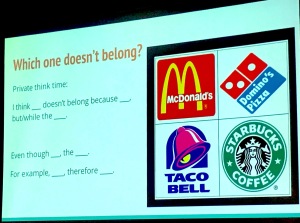 2) Word Banks: “Place Value, Decimal, Ten, Hundred, Thousand.” Here the students are pressed to use the given words and phrases in their responses.
2) Word Banks: “Place Value, Decimal, Ten, Hundred, Thousand.” Here the students are pressed to use the given words and phrases in their responses.
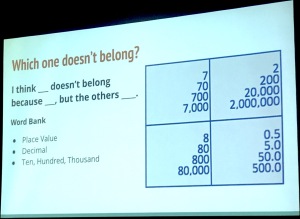
These two simple, yet powerful, strategies scaffold conversation for struggling learners, while also challenging all students to explain their thinking.
The Surprising Power of Gradual Reveal in Our Math Lessons: Steve Leinwand (American Institutes for Research)
- The Big Take-Away = “Instead of bombarding students with the entire word problem, graph, table or figure, gradually reveal it, using questions to probe understanding of prior and new content.“
- Cool Tool #1= “The Hidden Problem“
- Cool Tool #2= “Create the Visual Pattern”
- Gradual Reveal Example #1 (subtraction): Steve started by eviscerating, in true Steve Leinwand fashion, the notion of posing to students the following question:
Sarah has 91 empty boxes. She had 2605 apples to pack into the boxes. How many apples should she place into each box?
He instead showed how the very same textbook questioned could be gradually revealed by posing the following prompts one-at-a-time:
Sarah has 91 empty boxes.
– What can you infer about Sarah?
She had 2605 apples to pack into the boxes.
– Now what can you infer about Sarah?
– So what the 91 tell us? What about the 2605?
– What do you think the question is?
– About how many apples do you think would be in each box? <pre than 100? Less than 100? Convince us.
– Can you draw a picture?
– Can you create a number sentence?
– Do you multiply or divide? Why?
This gradual reveal offers opportunity to build interest and to scaffold, as well as for inferential reasoning and for a low-floor entry. - Gradual Reveal Example #2 (Data Tables): Before asking students to make decisions from a given data table, the data can be gradually revealed as such:
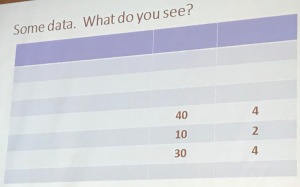
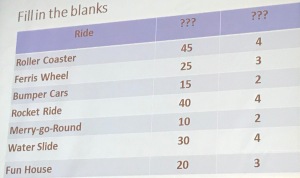
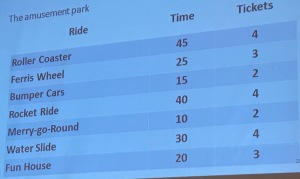 Once the students have taken a deep dive into the data and the context, they are finally presented with the task:
Once the students have taken a deep dive into the data and the context, they are finally presented with the task:
“The 4th and 2nd Graders in your school are going on a trip to the Amusement park. Each 4th Grader is going to buddy with a 2nd Grader. Your buddy wants to go on as many rides as possible. The bus will drop you off at 10:00 am and pick you up at 1:00 pm. Each student gets 20 tickets for rides. Use this information in the chart to write a letter to your buddy and create a plan for a fun day at the Amusement park.” - Gradual Reveal Example #3 (Data Displays): Again, rather given students all the information upfront, gradually reveal the data display before posing the more traditional mathematical questions:
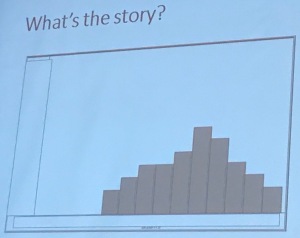

- The Hidden Problem: Again instead of posing a traditional subtraction problem such as 95 – 47, Steve posed this:
I have $95. You have $47.
What is the answer to the hidden problem?
Then Steve takes the various student answers, displays them to the class and asks, what is the hidden problem for each of these answers:
$142 $48 $71 $150 $50 You Me
(The hidden problems are: How do we have together? How much more do I have than you? How much do we each get if we share the total equally? About how much do we have together? About how much more do I have than you? Who has more? Who has less?)
Since the target of the lesson is two-digit subtraction, Steve then narrows the focus of the discussion with: “Let’s focus on how much richer I am than you. How do you know?” - Create the Visual Pattern: Many teachers are aware of the site/activity visual patterns. Steve applied the gradual reveal this solid task as well:

If this is stage 2, draw and describe stage 1. How would your stage 3 then look? - Steve summarized his talk of applying a new technique to teach an old idea by emphasizing that “Processes are as important as content.
I arrived at Steve’s session expected a talk on ‘Gradual Release,’ because that is what was advertised in the program. I was intrigued, because this conventional instructional tool of ‘I do-We do-You do’ does not mesh with much of the problem-solving and discussion-rich tasks that Steve is known to promote. His title slide’s use of the word ‘reveal’ , however, exposed the misprint in the program. So I thought the presentation was going to be about the Gradual Reel-In of ‘You do-We do – I do’ method of leading class discussions on a math task. While Gradual Reveal is in the same spirit as the Gradual Reel-in it has a different purpose. It is a means to lead students to a critical question, rather than to specific concept or understanding.


